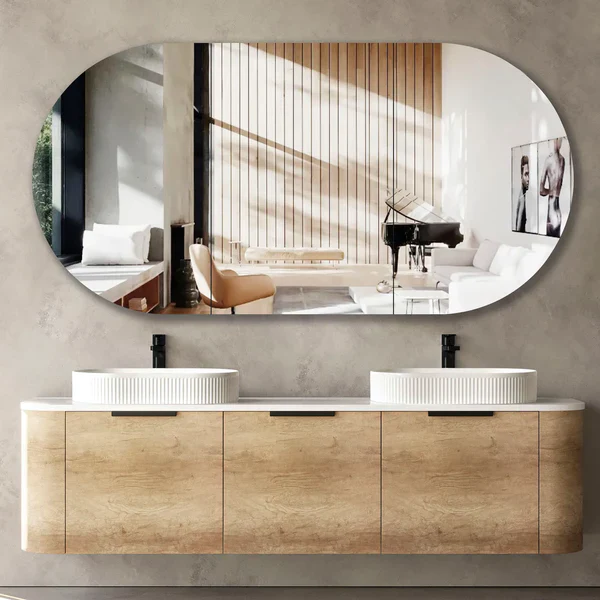Choosing the right material for your vanities and cabinets is crucial for both aesthetics and durability. With so many options available, it can be challenging to decide which material best suits your needs. This blog will explore the most common materials used in vanities and cabinets, their pros and cons, and how to select the right one for your space.
Common Materials for Vanities and Cabinets
Solid Wood
Solid wood is a classic choice for vanities and cabinets, offering unmatched durability and a timeless appearance. Common types include oak, maple, and cherry.
Pros:
- Long-lasting and durable
- Can be refinished to restore its look
- Adds a natural, warm aesthetic to any space
Cons:
- More expensive than other materials
- Susceptible to moisture damage, especially in humid environments
- Requires regular maintenance to prevent warping and cracking
Plywood
Plywood is a popular alternative to solid wood, made by layering thin sheets of wood veneer. It’s a strong, stable material often used in quality cabinetry.
Pros:
- Strong and resistant to warping and cracking
- More affordable than solid wood
- Lightweight and easy to work with
Cons:
- Exposed edges need finishing
- Limited grain patterns compared to solid wood
Medium-Density Fiberboard (MDF)
MDF is made from wood fibers and resin, resulting in a smooth and uniform material. It’s commonly used in modern vanities and cabinets due to its affordability.
Pros:
- Smooth surface ideal for painting
- Cost-effective and widely available
- Resistant to warping and cracking
Cons:
- Prone to water damage if not properly sealed
- Less durable than solid wood or plywood
- Can be heavy
Particleboard
Particleboard is made from wood chips and resin, making it a budget-friendly option for vanities and cabinets. However, it’s less durable than other materials.
Pros:
- Very affordable
- Lightweight and easy to install
- Smooth surface for veneers or laminates
Cons:
- Least durable, prone to sagging and damage
- Short lifespan, especially in humid environments
Laminate
Laminate is a versatile and affordable material often used as a surface finish over MDF or particleboard. It comes in various colors and patterns.
Pros:
- Available in a wide range of colors and designs
- Easy to clean and maintain
- Affordable and durable for everyday use
Cons:
- Can chip or peel over time
- Doesn’t have the luxurious feel of natural materials
- Difficult to repair once damaged
Metal (Stainless Steel and Aluminum)
Metal vanities and cabinets offer a sleek, modern look, ideal for contemporary spaces. They are highly durable and resistant to water and heat.
Pros:
- Extremely durable and long-lasting
- Resistant to water, heat, and stains
- Modern, industrial aesthetic
Cons:
- Can be expensive
- Shows fingerprints and smudges easily
- May not suit all design styles
Glass
Glass is often used for vanity tops and cabinet doors, adding an elegant and modern touch to your bathroom.
Pros:
- Elegant appearance that reflects light and brightens spaces
- Easy to clean and maintain
- Makes small spaces feel larger
Cons:
- Prone to cracking or breaking
- Requires frequent cleaning to avoid streaks and smudges
- Limited storage privacy
Specialty Materials for Vanities and Cabinets
Bamboo
Bamboo is an eco-friendly option that offers a unique look for vanities and cabinets. It’s durable and resistant to moisture, making it ideal for bathroom use.
Pros:
- Environmentally friendly and sustainable
- Durable and moisture-resistant
- Offers a distinctive, natural appearance
Cons:
- Can be more expensive than other materials
- Limited availability in some regions
- Color may change over time due to exposure to light
Reclaimed Wood
Reclaimed wood is a sustainable choice that adds character and history to your vanities and cabinets. It’s often used in rustic or vintage-style spaces.
Pros:
- Eco-friendly and sustainable
- Unique, rustic appearance with a story behind it
- Strong and durable
Cons:
- Can be expensive due to the sourcing and treatment process
- Inconsistent quality and appearance
- May require more maintenance
Concrete
Concrete is increasingly popular for vanity tops due to its industrial look and customizable nature. It’s a durable and stylish choice for modern bathrooms.
Pros:
- Industrial, modern aesthetic
- Customizable in terms of color and texture
- Extremely durable and long-lasting
Cons:
- Heavy, requiring strong support structures
- Prone to cracking over time
- Requires regular sealing to prevent stains
Choosing the Right Material
When selecting the right material for your vanities and cabinets, several factors should influence your decision:
Considerations
- Budget: Your budget will likely play a significant role in your choice of material. Solid wood and custom options tend to be more expensive, while MDF and particleboard are more budget-friendly.
- Environment: Consider the environment where the vanity or cabinet will be placed. Bathrooms with high humidity levels may benefit from materials like metal or properly sealed plywood that resist moisture damage.
- Style: Your personal style and the overall design of your space should guide your material choice. For example, solid wood or reclaimed wood may suit traditional or rustic designs, while metal and glass are ideal for modern, contemporary spaces.
- Maintenance: Different materials require different levels of care. If you prefer low-maintenance options, materials like laminate or metal might be best, whereas solid wood may require more upkeep.
Mixing Materials
To achieve a balance between functionality and aesthetics, consider mixing materials in your design. For instance, a vanity with a solid wood base and a concrete countertop can combine the warmth of wood with the modern appeal of concrete.
For more ideas on the best vanities and cabinets to suit your space, explore various options available that match your style and functional needs.
Conclusion
Choosing the right material for your vanities and cabinets is essential for both the look and longevity of your space. Whether you prioritize durability, budget, or design, there’s a material that fits your needs. Take the time to assess your options, and don’t hesitate to consult with professionals to ensure you make the best choice for your home.







